I never truly appreciated laing until I moved away for college. After countless failed attempts at recreating my Lola's version (and yes, some ended up looking like swamp soup), I finally perfected this authentic Bicolano Laing recipe that takes me right back to Bicol.
This creamy, spicy gabi sa gata hits differently. Imagine tender liempo swimming in rich coconut milk that's been slowly simmered with dried taro leaves until the sauce turns that signature orange-red color.
Once you master this authentic Bicol laing recipe, you'll be everyone's favorite person to invite to potlucks. And the best part? That moment when the orange oil starts floating to the top (you know what I'm talking about), that's when you know you've nailed this laing recipe.
Jump to:
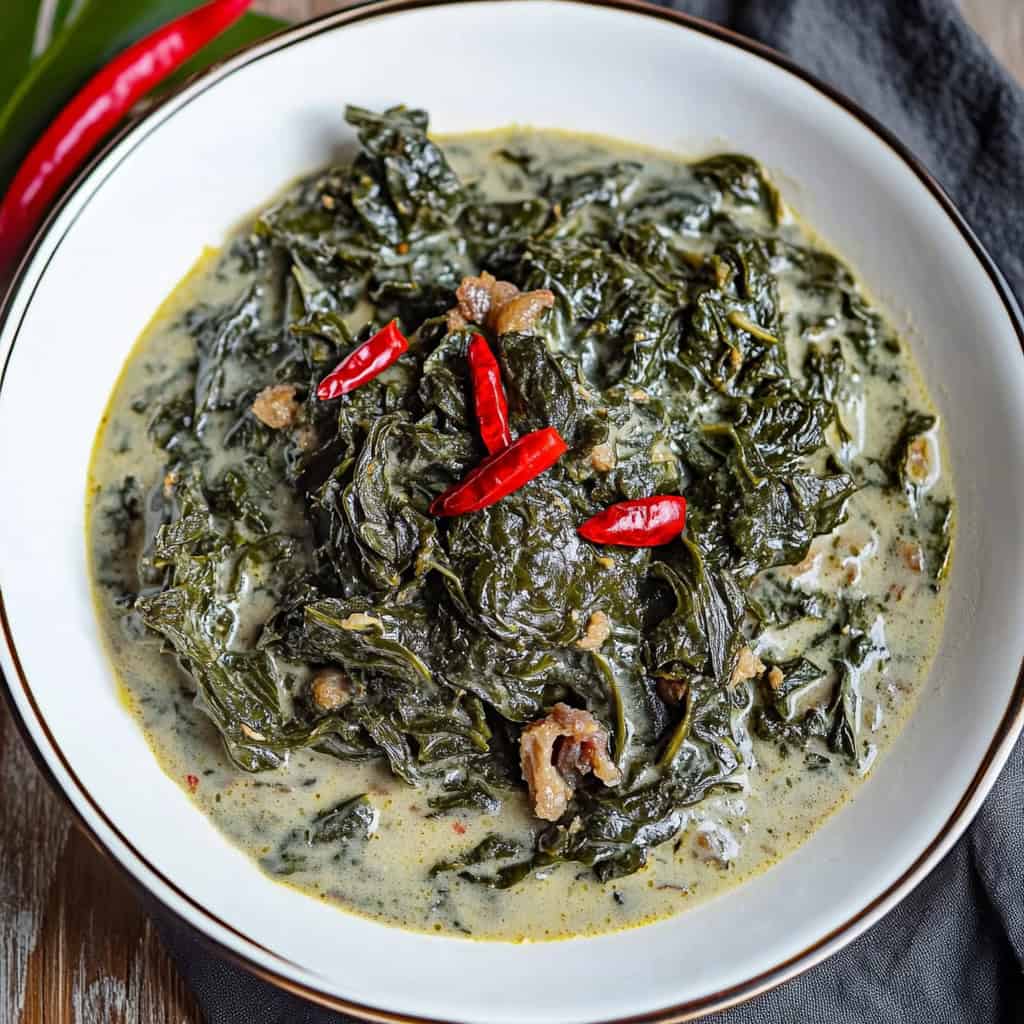
Why You'll Love This Recipe
- Rich and Creamy: The combination of kakang gata (coconut cream) and gata (coconut milk) creates an irresistibly creamy sauce
- Perfectly Spiced: Customizable heat levels make it enjoyable for everyone
- One-Pot Wonder: Everything cooks in a single pot, minimizing cleanup
- Budget-Friendly: Uses simple ingredients that can be found in any Filipino market
- Make-Ahead Friendly: Tastes even better the next day
- Authentic Technique: Traditional Bicolano method passed down through generations
Ingredients
Each ingredient in this recipe plays a vital role in creating authentic Bicolano Laing. Dried taro leaves form the foundation, providing the unique earthy flavor that cannot be substituted. Fatty pork belly adds richness and helps create the signature orange oil.
Coconut milk and cream deliver the luxurious texture, while Thai chilies bring the essential Bicolano heat. The aromatics (lemongrass, garlic, ginger, onion, and shrimp paste) create a fragrant base that gives depth to the dish.
This perfect balance of ingredients results in the creamy, spicy, and deeply satisfying flavor that makes laing a beloved Filipino classic.
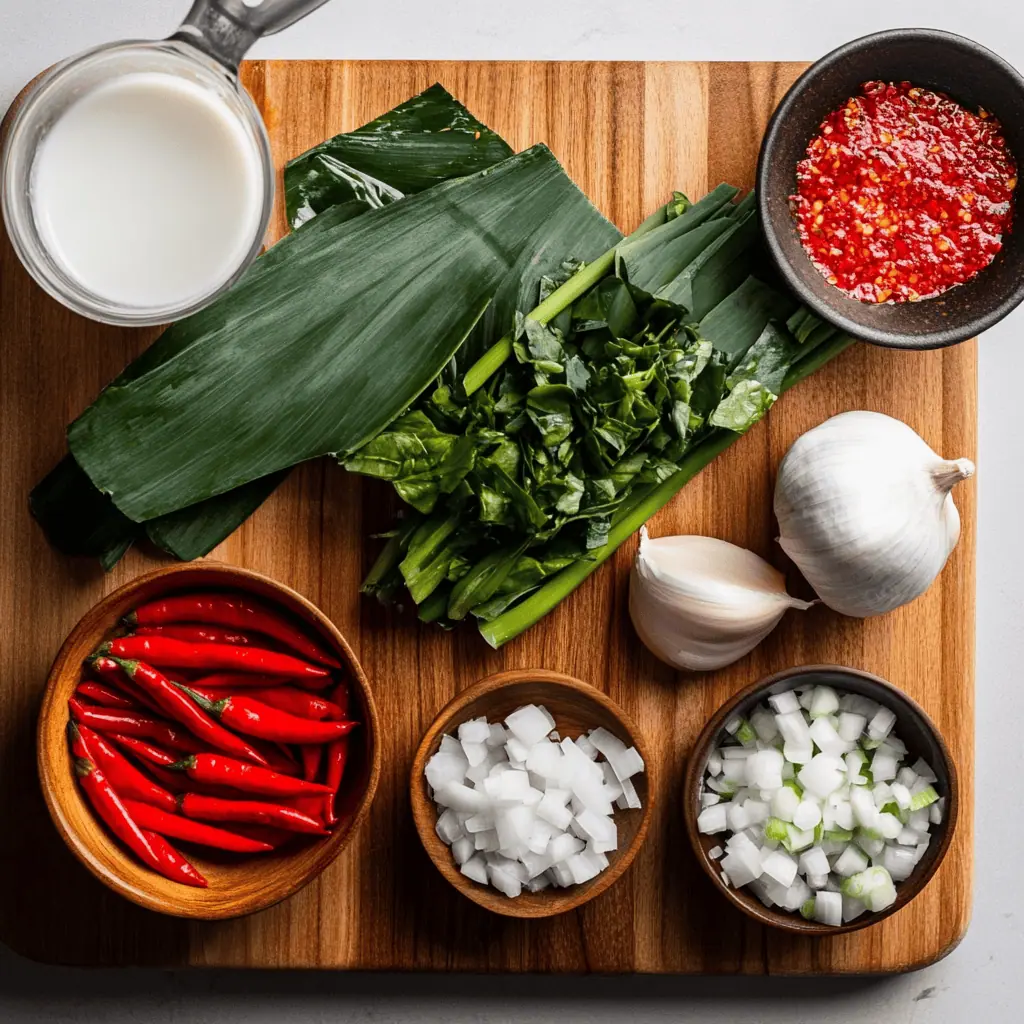
Main Ingredients
- 2 ounces (about 60g) dried gabi (taro) leaves
- 1 pound (450g) pork belly, diced into 1-inch cubes
- 4 cups (960ml) coconut milk
- 1 cup (240ml) coconut cream (kakang gata)
- 8 Thai chili peppers (siling labuyo), whole or sliced
Aromatics
- 2 lemongrass stalks, bruised and tied into knots
- 1 medium onion, peeled and finely chopped
- 4 cloves garlic, peeled and minced
- 1 thumb-sized piece ginger, peeled and minced
- 1 tablespoon shrimp paste (bagoong alamang)
- Salt and freshly ground black pepper to taste
- 1 tablespoon canola oil
Equipment
- Large Heavy-Bottomed Pot (Kaldero): Essential for even heat distribution and preventing the coconut milk from curdling. A Dutch oven or cast-iron pot works perfectly.
- Wooden Spoon: For gently pushing down the leaves without breaking them. Metal utensils can be too harsh.
- Sharp Chef's Knife: For preparing the pork belly and aromatics.
- Cutting Board: Preferably separate ones for meat and vegetables.
- Measuring Cups and Spoons: For accurate ingredient proportions.
- Mortar and Pestle (Optional): Traditional tool for crushing garlic, ginger, and chilies to release more flavor.
- Heat-Resistant Gloves: For protection when handling the dried taro leaves, which can sometimes cause mild irritation even when dried.

How To Make
- Prepare the Taro Leaves: Inspect your dried taro leaves carefully. They should be brittle to the touch and free from any discoloration or mold. Break them into smaller, manageable pieces (about 2 inches) and set aside. Clean, dry hands are best for this task.
- Prepare the Base: Heat canola oil in your heavy-bottomed pot over medium heat. Once hot, add minced garlic, chopped onions, and ginger. Sauté until the onions become translucent and the garlic turns slightly golden, about 3-4 minutes.
- Cook the Pork: Add the diced pork belly to the pot. Cook until the meat starts to brown lightly and render some fat, about 5-7 minutes. Add the shrimp paste and stir well to combine with the meat and aromatics.
- Begin the Simmering Process: Pour in the coconut milk (saving the coconut cream for later). Add the bruised lemongrass stalks and Thai chili peppers. Bring to a very gentle simmer - you should only see small bubbles forming at the edges of the pot.
- Add the Taro Leaves: This is a crucial step - add your dried taro leaves but DO NOT STIR for the first 10 minutes. Let them naturally sink into the coconut milk. Cover the pot and maintain a gentle simmer over low-medium heat.
- First Integration: After 10 minutes, gently push down any floating leaves with a wooden spoon. Avoid stirring vigorously. Continue cooking for about 25 minutes more, or until the leaves have significantly darkened and softened.
- Add the Richness: Pour in the coconut cream and continue simmering. The key here is patience - cook until you see the orange-red oil starting to separate and float to the surface. This typically takes about 20-25 minutes more.
- Final Seasoning: Season with salt and pepper to taste. If you prefer it spicier, you can add more chilies at this point. The final consistency should be creamy but not soupy - the sauce should coat the back of your spoon.
- Rest Before Serving: Let the laing rest for 5-10 minutes before serving. This allows the flavors to settle and the sauce to thicken slightly more.

Tips from Lola's Kitchen
- Low and Slow: Never rush laing. The magic happens during the slow simmer—this is what transforms tough leaves into silky tenderness.
- The Orange Oil Test: When bright orange oil appears on top, your laing is authentic. If you don't see it, continue cooking on low heat.
- Prep Dried Leaves Properly: Gently crush dried taro leaves before adding them to release more flavor and help them absorb the coconut milk faster.
- Layer Your Flavors: Add coconut cream only after the leaves have softened to create distinct layers of flavor development.
- Rest Before Serving: Like many stews, laing tastes better after resting for 15-30 minutes as flavors continue to meld.
- Cook with Bagoong Alamang: Always use shrimp paste in the initial cooking phase—this builds the umami foundation that distinguishes exceptional laing.
- Choose the Right Pot: A clay pot (palayok) or cast iron dutch oven helps maintain consistent low heat, crucial for proper oil separation.
- The Wooden Spoon Rule: Only use wooden spoons with laing to prevent breaking down the leaves too much during the gentle pushing down process.
Substitutions
- Pork Belly: Substitute with smoked fish (tinapa), dried fish (tuyo), or shrimp for a seafood version. For a leaner option, use pork shoulder or chicken thigh meat.
- Thai Chilies: Bird's eye chilies, serrano peppers, or even dried chili flakes can work. Adjust quantity based on your heat preference. For a milder version, remove the seeds or reduce the quantity.
- Lemongrass: Dried lemongrass, lemon zest mixed with a pinch of ginger, or kaffir lime leaves can provide a similar aromatic quality.
- Shrimp Paste: Fish sauce (patis), anchovy paste, or even miso paste (for a non-seafood option) can provide the umami depth, though the flavor profile will differ slightly.
- Coconut Products: If fresh coconut milk/cream is unavailable, high-quality canned versions work well. In a pinch, coconut milk powder reconstituted with warm water can be used, though the richness may be slightly reduced.
- Taro Leaves: While there is NO safe substitute for dried taro leaves if you want authentic laing, collard greens or kale (dried yourself) can be used for a non-traditional adaptation with a similar texture. Note that the flavor will be significantly different.
Troubleshooting
The Leaves Cause Itchiness
- Problem: This happens when taro leaves aren't properly dried or cooked long enough.
- Solution: Ensure leaves are brittle-dry before cooking and simmer until completely tender. Always buy from reputable sources. If persistent, soak dried leaves in water with a splash of vinegar for 10 minutes, then drain thoroughly before using.
Curdled Coconut Milk
- Problem: High heat or vigorous boiling causes separation.
- Solution: Cook on low heat throughout the entire process. If curdling begins, lower the heat immediately and stir very gently. Prevention is key—never allow the mixture to boil.
Too Dry
- Problem: Overcooked or insufficient liquid.
- Solution: Add more coconut milk gradually, ¼ cup at a time. Allow each addition to integrate fully before adding more.
Too Wet
- Problem: Undercooked or too much liquid.
- Solution: Continue simmering uncovered until the desired consistency is reached. Patience is key—authentic laing requires slow reduction to concentrate flavors.
Bland Flavor
- Problem: Insufficient seasoning or poor-quality ingredients.
- Solution: Add more shrimp paste, salt, or fish sauce. Quality dried taro leaves and fresh coconut milk are essential for authentic flavor.
Excessive Spiciness
- Problem: Too many chilies or particularly potent ones.
- Solution: Add more coconut cream to temper the heat. Remove some of the chilies if possible. Serve with extra rice and perhaps a cooling side dish.
Storage & Reheating
Refrigeration
- Transfer cooled laing to an airtight container.
- Refrigerate for up to 4 days.
- The flavor actually improves after a day as ingredients meld together.
Freezing
- Freeze in portion-sized airtight containers for up to 3 months.
- Label with date and contents.
- Leave some space at the top of containers as the dish may expand slightly when frozen.
Reheating
- Stovetop (Preferred Method): Reheat gently over low heat, adding a splash of coconut milk if needed to restore creaminess. Stir occasionally until heated through.
- Microwave (Quick Option): Use 70% power in 1-minute intervals, stirring between each interval to promote even heating. Cover loosely to prevent splattering.
- Avoid: High heat or rapid boiling when reheating as this can break the emulsion and affect texture.

FAQ
Why must taro leaves be dried? Can I use fresh ones?
NEVER use fresh taro leaves. They contain calcium oxalate crystals that cause severe irritation to the mouth, throat, and skin. The drying process neutralizes these crystals and is essential for safety. Additionally, drying concentrates the flavor, creating the distinctive taste of authentic laing.
How do I select quality dried taro leaves?
Look for leaves that are brittle, dark green to grayish-green in color, and free from mold or discoloration. They should snap easily when bent. Avoid leaves that feel damp or have a musty smell.
Can I make laing less spicy without compromising authenticity?
Yes! While Bicolano cuisine is known for heat, authentic laing can be adjusted to your preference. Use fewer chilies or remove seeds before adding. You can also keep chilies whole and remove them before serving for a milder infusion of heat.
Why is my laing bitter?
Bitterness usually comes from low-quality dried leaves or leaves that weren't properly processed. Always source from reputable suppliers. A slight bitterness can be countered by adding a teaspoon of sugar or increasing the coconut cream.
How do I achieve the orange-red oil separation?
Patience is key. The oil separation happens naturally after extended cooking (usually 45-60 minutes total). Ensure you're using sufficient fat (from pork and coconut cream) and maintain a consistent low heat throughout the cooking process.
Is laing healthy?
Traditional laing contains nutritious taro leaves high in fiber, vitamins A and C, and minerals. However, the coconut milk and pork make it calorie-dense. For a healthier version, use leaner meat like chicken breast or seafood, reduce coconut cream, and increase the ratio of leaves.
Can I prepare laing in advance for a party?
Absolutely! Laing actually tastes better 1-2 days after cooking as the flavors develop. Prepare it ahead, refrigerate, and gently reheat before serving. Add fresh coconut cream during reheating for an extra luxurious texture.
Where can I find dried taro leaves outside the Philippines?
Look in Filipino, Southeast Asian, or international grocery stores. Online Filipino specialty shops are also good sources. Search for "dried gabi leaves," "dried taro leaves," or "dahon ng gabi." If unavailable, consider joining Filipino community groups who may know local sources.
Related
Looking for other recipes like this? Try these:

Authentic Bicolano Laing (Gabi Leaves in Coconut Milk)
Ingredients
Main Ingredients
- 2 ounces dried gabi (taro leaves) you must never use fresh taro leaves, as they contain calcium oxalate crystals that can cause severe irritation
- 1 pound pork belly diced
- 4 cups coconut milk
- 1 cup coconut cream
- 8 Thai chili peppers might be too intense for non-Bicolano palates
Aromatics
- 2 lemongrass stalks
- 1 onion peeled and chopped
- 4 cloves garlic peeled and minced
- 1 thumb-size ginger peeled and minced
- 1 tablespoon shrimp paste
- Salt and pepper to taste
- 1 tablespoon canola oil
Instructions
- First, inspect your dried taro leaves (tuyong dahon ng gabi) carefully. They should be brittle to the touch and free from any discoloration or mold. Break them into smaller, manageable pieces and set aside. If the pieces are too large (malalaki), you can gently crumble them using clean, dry hands (malinis at tuyong kamay).
- Heat canola oil in a large, heavy-bottomed pot (makapal na kaldero) over medium heat (katamtamang init). Once hot, add your minced garlic (bawang), chopped onions (sibuyas), and ginger (luya). Sauté until the onions become translucent and the garlic turns slightly golden (hanggang maging malinaw ang sibuyas at mag-golden brown ang bawang), about 3-4 minutes.
- Add the diced pork belly (liempo) to the pot. Cook until the pork starts to brown lightly, about 5-7 minutes. Add the shrimp paste (bagoong alamang) and stir well to combine with the meat and aromatics.
- Pour in the coconut milk (gata) but leave the coconut cream (kakang gata) for later. Add the bruised lemongrass stalks (tanglad) and Thai chili peppers (siling labuyo). Bring to a very gentle simmer (pakuluan ng dahan-dahan) - you should only see small bubbles forming.
- Now comes an important step: add your dried taro leaves but DO NOT STIR (huwag haluin) for the first 10 minutes. Let them naturally sink into the coconut milk. Cover the pot and maintain a gentle simmer at low-medium heat (mahina hanggang katamtamang init).
- After 10 minutes, you can now gently push down any floating leaves with a wooden spoon. Still avoid stirring vigorously. Continue cooking for about 25 minutes more, or until the leaves have significantly darkened and softened.
- Add the coconut cream (kakang gata) and continue simmering. The key here is patience - cook until you see the orange-red oil starting to separate and float to the surface (hanggang lumitaw ang pulang langis sa ibabaw). This usually takes about 20-25 minutes more. This orange-red oil (pulang langis) is your sign of a properly cooked laing.
- Season with salt and pepper to taste (timplahan ng asin at paminta). If you want it spicier, you can add more chilies at this point. The final consistency should be creamy but not soupy (malapot pero hindi masabaw) - the sauce should coat the back of your spoon.
- Let it rest for 5-10 minutes before serving. This allows the flavors to settle and the sauce to thicken slightly more. Serve hot with freshly steamed rice (mainit na kanin).
Your laing is ready when:
- The pork is fork-tender (malambot ang karne)
- The sauce is thick and creamy (malapot)
- Orange-red oil has surfaced (may pulang mantika sa ibabaw)
- The leaves are very tender and dark (malambot at maitim ang dahon)
- No more raw coconut milk smell remains (wala nang amoy ng hilaw na gata)
Tips from Lola's Kitchen
- Always use dried taro leaves - fresh ones can cause intense itching
- The best laing has visible orange oil on top
- Never boil the coconut milk vigorously to prevent curdling
- Choose darker dried taro leaves for better flavor
- When reheating, add a splash of coconut milk if needed
Nutrition
The Story Behind Bicolano Laing
Laing (Pinangat na Gabi), the iconic dish from the Bicol region, stands as a fiery testament to the Philippines' diverse culinary landscape. What makes this dish extraordinary is how it transforms humble dried taro leaves into a creamy, spicy delicacy using coconut milk and chili—ingredients that grow abundantly in Bicol's fertile volcanic soil. The preservation technique of drying taro leaves wasn't just practical; it intensified their flavor and created a unique texture that's become the hallmark of authentic laing.
The Bicolanos, known throughout the Philippines as masters of spicy coconut milk-based dishes, elevated laing from a simple farmer's meal to a celebrated regional delicacy. Their genius lies in the careful layering of flavors: the earthiness of dried taro leaves, the richness of kakang gata (first-press coconut milk), the umami from dried fish or shrimp, and the signature heat from local siling labuyo (bird's eye chilies). This combination reflects Bicol's geography—a region blessed with abundant coconut trees, volcanic soil perfect for taro cultivation, and a culture that embraces bold, spicy flavors.
Today, while laing has found its way into high-end restaurants and homes across the Philippines and abroad, true Bicolano laing remains distinct in its preparation and taste. The secret lies not just in the ingredients but in the patient, slow-cooking process that allows the dried taro leaves to absorb the coconut milk completely, creating that signature creamy texture with a spicy kick. This dish perfectly embodies the Bicolano spirit: resourceful, bold, and unapologetically spicy.
Remember: Real laing should have that perfect balance of creamy and spicy, where the coconut milk doesn't just tame the heat but dances with it, creating a flavor explosion that's distinctly Bicolano.
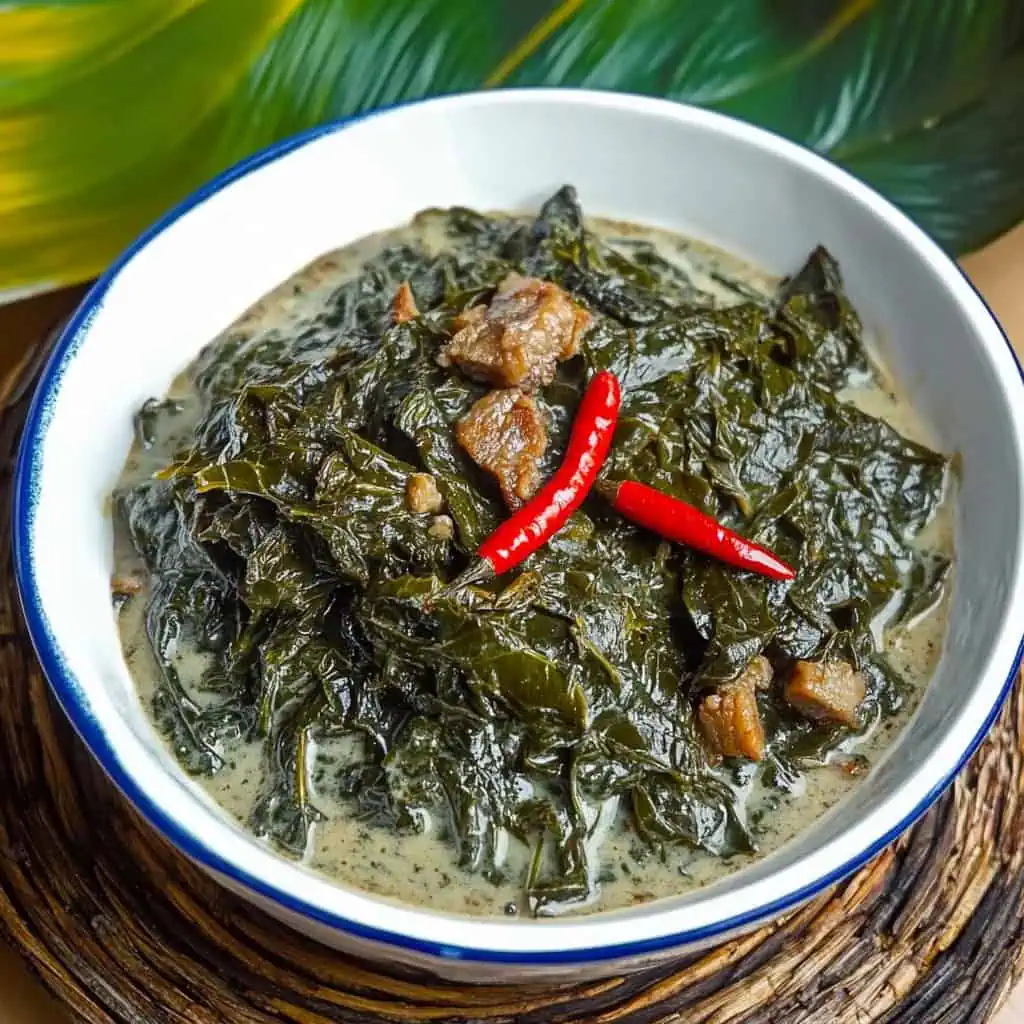






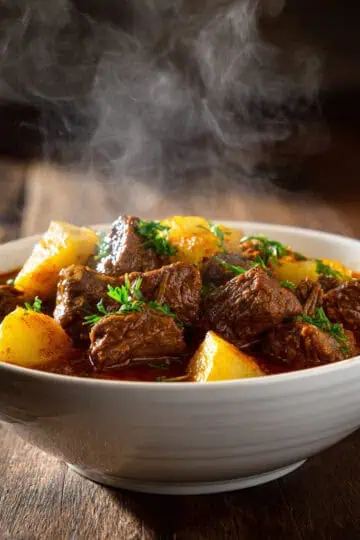
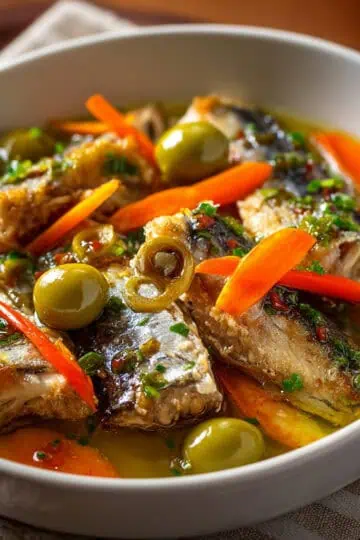
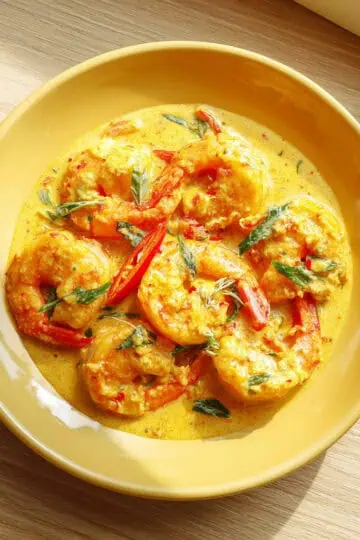
Rolandmaype says
tastes good especially when served hot
BennyRhymn says
I love it